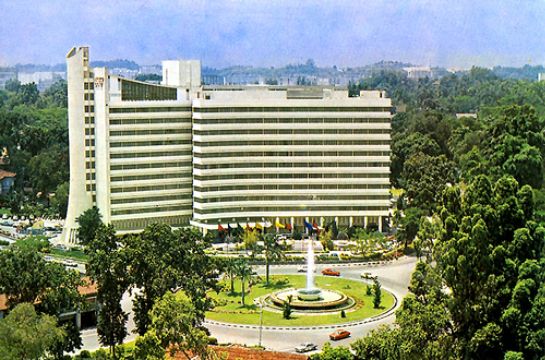The Marco Polo Hotel, also known as the Omni Marco Polo Hotel after 1989, was built in 1968 on Tanglin Road, and it was one of Singapore’s famous landmarks and my favorite hangout at the time I was living there. It had the fine dining restaurant Le Duc and the more informal La Brasserie both good in their particular category. It was also home to Le Club, which I joined in 1989 or 1990, a private “members only” nightclub that was very popular and attracted an elite crowd. It had a separate entrance from the hotel’s main entrance slightly hidden to the right on the ground floor. The hotel was torn down in 1999 with barely a second thought, the excuse given was quite obscure, related to a downturn in business caused by the recession of the late nineties, and perceived competition from an adjacent hotel called the Trader’s; on its site now sits yet another boring condominium called the Grange Residences and a big chunk of Singapore’s history is gone forever.
According to details from the archives of the National Library Board (the National Library Building has since succumbed and it has also been scraped):
“The Marco Polo Hotel, at the junction of Tanglin Road and Grange Road, was originally known as Hotel Malaysia when it was first constructed in 1968. Designed by Alfred Wong Partnership, it was a 10 storey building with 300 rooms built in contemporary architectural style. It was owned by the Goodwood Group and the hotel interiors boasted jade, green onyx, marble and teak carvings. It also had a roof-top restaurant. Lobby lounge girls dressed in cheongsams added to the exotic look of the hotel and it was well-known for its high quality service. The exterior was simple with a broad sweeping facade and little ornamentation. Big trees, birds and a water fountain however added charm to the hotel’s grounds. Additions and changes were made to the hotel in 1981, again by Alfred Wong Partnership. The hotel’s architecture won it the 1983 Singapore Institute of Architects’ Award for Outstanding Building. In 1988, the hotel went through a $30 million redecoration programme, adding a new coffeshop and shopping arcade and an enlarged lobby. From 1983 to 1988, the hotel was consecutively voted as one of the top 10 business hotels in the world by the British-based magazine, Business Traveller. The hotel was so popular in the 1970s that many famous personalities chose to stay here during their visit to Singapore. They include British pop singer Sir Cliff Richard, Hollywood actor Roger Moore, Prince Sufri Bolkiah of Brunei and former British Prime Minister Edward Heath. The hotel was selected as the runner-up in the Overseas Best City Hotel category in the Hotel of the Year 1990 presentation in London.”
“Its success notwithstanding, the hotel’s ownership changed hands twice. In 1973, the Goodwood Group sold it to the Hongkong and Kowloon-based Wharf and Godown Company Limited, and in 1986, it was taken over by Marco Polo Developments, a group which is 75 per cent-owned by Hong Kong’s Wheelock Group.”
It is staggering to think of how many stately structures and historic edifices have suffered this same fate in Singapore, due in part to greed or corruption—and how many more will follow. I read somewhere, that even the famous landmark The Singapore Cricket Club might fall victim to demolition if people continue to allow this to happen.


